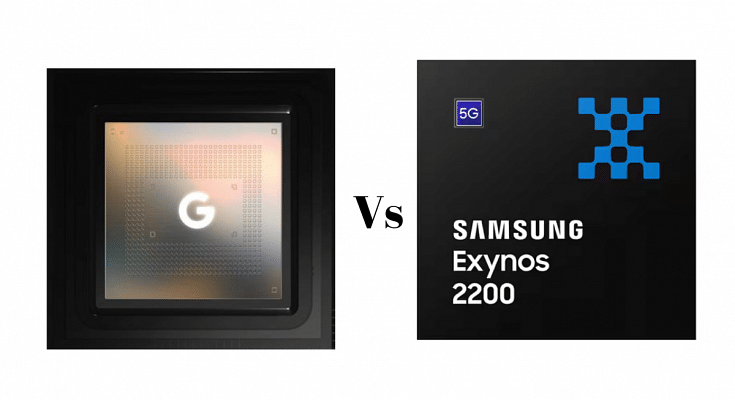Two prominent contenders are the Google Tensor and the Exynos 2200 chipsets. These chipsets are behind some of the most advanced and feature-packed smartphones on the market.
In this article, we will compare these two chipsets in terms of fabrication, CPU architecture, GPU capabilities, memory, multimedia support, and connectivity.
Also Read: Xiaomi Watch 2 Pro With AMOLED Dial, Snapdragon W5+ Gen 1 Chipset Launched: Full Specs, Price
Google Tensor Vs Exynos 2200: Fabrication, CPU Architecture
| Feature | Google Tensor | Exynos 2200 |
|---|---|---|
| Fabrication | 5 nanometers | 4 nanometers |
| CPU Architecture | – 2x Cortex-X1 cores at 2.8 GHz | – 1x Cortex-X2 core at 2.8 GHz |
| – 2x Cortex-A76 cores at 2.25 GHz | – 3x Cortex-A710 cores at 2.52 GHz | |
| – 4x Cortex-A55 cores at 1.8 GHz | – 4x Cortex-A510 cores at 1.82 GHz |

The Google Tensor chipset is built on a 5-nanometer process and boasts an impressive CPU architecture. It features a combination of cores, including 2x Cortex-X1 cores clocked at 2.8 GHz, 2x Cortex-A76 cores at 2.25 GHz, and 4x Cortex-A55 cores at 1.8 GHz. This diverse setup ensures excellent performance across various tasks.
On the other hand, the Exynos 2200 is manufactured using a more advanced 4-nanometer process. It comprises 1x Cortex-X2 core at 2.8 GHz, 3x Cortex-A710 cores at 2.52 GHz, and 4x Cortex-A510 cores at 1.82 GHz. The Exynos 2200’s CPU architecture promises a blend of power efficiency and high performance, especially with the introduction of the Cortex-X2 core.
Also Read: Unisoc T820 Vs MediaTek Dimensity 6100 Plus: Mid-Range Chipset Comparison 2023
Google Tensor Vs Exynos 2200: GPU Comparison
| Feature | Google Tensor | Exynos 2200 |
|---|---|---|
| GPU Name | Mali-G78 MP20 | Samsung Xclipse 920 |
| GPU Frequency | 848 MHz | 810 MHz |
| Execution Units | 20 | 3 |
| Shading Units | 1280 | 640 |

The Tensor chipset is equipped with a Mali-G78 MP20 GPU, which operates at a frequency of 848 MHz and has 20 execution units. With 1280 shading units, it delivers a robust performance, making it capable of handling demanding graphics-intensive tasks and gaming with ease.
In contrast, the Exynos 2200 features the Samsung Xclipse 920 GPU. It operates at 810 MHz and has 3 execution units and 640 shading units, providing a significant boost in graphics performance compared to its predecessors.
Google Tensor Vs Exynos 2200: Memory, Multimedia (ISP) Comparison
| Feature | Google Tensor | Exynos 2200 |
|---|---|---|
| Memory Type | LPDDR5 | LPDDR5 |
| Memory Frequency | 3200 MHz | 3200 MHz |
| Camera Resolution | 1x 200MP | 1x 200MP |
| Video Capture | 4K at 60FPS | 8K at 30FPS, 4K at 120FPS |
| Video Playback | 4K at 60FPS | 8K at 60FPS, 4K at 240FPS |
| Video Codecs | H.264, H.265, AV1, VP9 | H.264, H.265, AV1, VP9 |
| Audio Codecs | AAC, AIFF, CAF, MP3, MP4, WAV | AAC, AIFF, CAF, MP3, MP4, WAV |

Both chipsets come with LPDDR5 memory technology, operating at a frequency of 3200 MHz, offering excellent multitasking capabilities. However, there are some differences in multimedia processing:
The Google Tensor includes a dedicated Tensor Processing Unit (NPU), enhancing its AI and machine learning capabilities. It supports a maximum camera resolution of 1x 200MP and can capture and playback 4K video at 60FPS. It also supports a variety of video and audio codecs for versatile multimedia experiences.
The Exynos 2200 also incorporates an NPU for AI tasks and offers similar camera capabilities with a maximum resolution of 1x 200MP. However, it stands out with its ability to capture 8K video at 30FPS and playback 8K video at 60FPS, providing a superior multimedia experience.
Also Read: MediaTek Helio G36 Vs Qualcomm Snapdragon 480 Entry-Level Gaming Chipset Comparison
Google Tensor Vs Exynos 2200: Final Verdict

The choice between them depends on your specific needs. If you prioritize AI capabilities and versatile camera performance, the Google Tensor is a good choice. On the other hand, if you’re looking for exceptional graphics and high-quality video playback, the Exynos 2200 with its powerful GPU and 8K video capabilities might be more appealing.
Ultimately, your decision should align with your usage patterns and preferences, as both chipsets promise exceptional performance and a delightful user experience.
Also Read: Qualcomm Snapdragon 732G Vs MediaTek Helio G88 Chipset Comparison: Which One Fairs The Competition?
